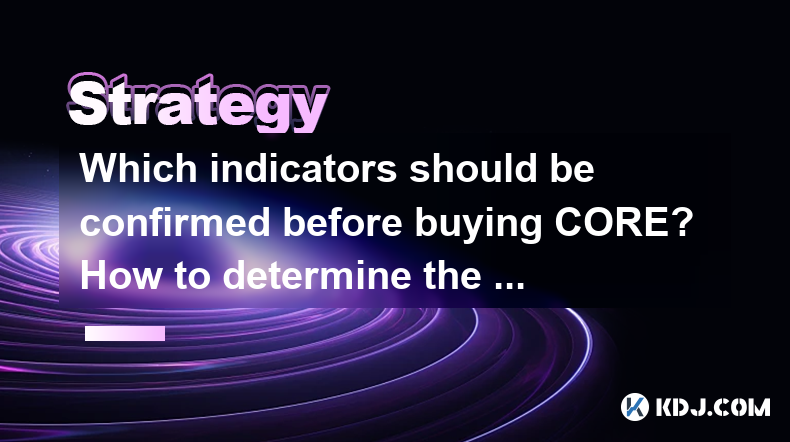-
 bitcoin
bitcoin $122659.385674 USD
0.52% -
 ethereum
ethereum $4484.113342 USD
-0.09% -
 bnb
bnb $1304.229256 USD
-0.85% -
 tether
tether $1.000204 USD
-0.03% -
 xrp
xrp $2.860636 USD
-0.51% -
 solana
solana $227.288799 USD
2.36% -
 usd-coin
usd-coin $0.999805 USD
0.01% -
 dogecoin
dogecoin $0.252837 USD
1.18% -
 tron
tron $0.341149 USD
1.12% -
 cardano
cardano $0.830507 USD
0.33% -
 hyperliquid
hyperliquid $45.792319 USD
0.04% -
 chainlink
chainlink $22.422164 USD
1.55% -
 ethena-usde
ethena-usde $1.000283 USD
0.01% -
 sui
sui $3.511389 USD
0.83% -
 stellar
stellar $0.385276 USD
-0.44%
Which indicators should be confirmed before buying CORE? How to determine the best time to enter the market?
Use SMA, EMA, RSI, Bollinger Bands, and MACD to confirm entry points for buying CORE, and consider market sentiment and volume for optimal timing.
May 11, 2025 at 07:22 am

When considering the purchase of a cryptocurrency like CORE, it's essential to use a variety of technical indicators to confirm the right time to enter the market. This approach helps in minimizing risks and maximizing potential returns. In this article, we will explore the key indicators you should confirm before buying CORE and how to determine the best time to enter the market.
Understanding CORE and Its Market Position
Before diving into the technical indicators, it's crucial to understand what CORE is and its position in the cryptocurrency market. CORE is a cryptocurrency that aims to provide a scalable and secure platform for decentralized applications. Its market position can be influenced by various factors such as market sentiment, technological developments, and overall market trends. Understanding these aspects can provide a foundational context for your analysis.
Key Technical Indicators to Confirm Before Buying CORE
To make informed decisions about buying CORE, you should confirm several key technical indicators. These indicators help in assessing the market's direction and potential entry points.
Moving Averages
Moving averages are essential tools for identifying trends and potential entry points. The two most commonly used are the Simple Moving Average (SMA) and the Exponential Moving Average (EMA).
- SMA: This indicator calculates the average price of CORE over a specific period, smoothing out price fluctuations. A common strategy is to look for the 50-day SMA and the 200-day SMA. If the 50-day SMA crosses above the 200-day SMA, it's known as a 'golden cross,' indicating a potential bullish trend.
- EMA: The EMA gives more weight to recent prices, making it more responsive to new information. A 20-day EMA crossing above a 50-day EMA can also signal a bullish trend.
Relative Strength Index (RSI)
The Relative Strength Index (RSI) is a momentum oscillator that measures the speed and change of price movements. It ranges from 0 to 100 and is typically used to identify overbought or oversold conditions.
- An RSI value above 70 suggests that CORE might be overbought, indicating a potential price correction.
- An RSI value below 30 suggests that CORE might be oversold, indicating a potential buying opportunity.
Bollinger Bands
Bollinger Bands consist of a middle band being an SMA and two outer bands that are standard deviations away from the middle band. They help in understanding volatility and potential price breakouts.
- When the price of CORE moves towards the upper Bollinger Band, it may indicate that the asset is overbought.
- When the price moves towards the lower Bollinger Band, it may indicate that the asset is oversold.
- A squeeze in the Bollinger Bands can signal a period of low volatility, which is often followed by a significant price move.
MACD (Moving Average Convergence Divergence)
The MACD is a trend-following momentum indicator that shows the relationship between two moving averages of CORE's price.
- The MACD line is calculated by subtracting the 26-day EMA from the 12-day EMA.
- The signal line is a 9-day EMA of the MACD line.
- A bullish signal occurs when the MACD line crosses above the signal line.
- A bearish signal occurs when the MACD line crosses below the signal line.
Determining the Best Time to Enter the Market
After confirming the key technical indicators, the next step is to determine the best time to enter the market. This involves combining the insights from the indicators and understanding market conditions.
Combining Indicators
Using multiple indicators can provide a more robust analysis. For instance, if the 50-day SMA crosses above the 200-day SMA (golden cross), and the RSI is below 30, it might indicate a strong buying opportunity. Similarly, if the MACD line crosses above the signal line while the price is near the lower Bollinger Band, it could confirm a potential upward move.
Market Sentiment and Volume
In addition to technical indicators, it's important to consider market sentiment and trading volume.
- Market sentiment can be gauged through news, social media, and sentiment analysis tools. Positive sentiment can drive demand for CORE.
- Trading volume indicates the level of interest in CORE. A significant increase in volume alongside bullish indicators can confirm a strong entry signal.
Practical Steps to Enter the Market
Once you have confirmed the indicators and assessed market conditions, you can take the following steps to enter the market:
- Choose a reliable exchange: Select a reputable cryptocurrency exchange that supports CORE trading.
- Set up your account: Complete the necessary verification processes and deposit funds into your account.
- Place your order: Decide whether to use a market order or a limit order. A market order will execute immediately at the current market price, while a limit order allows you to set a specific price at which you want to buy CORE.
- Monitor your position: After entering the market, keep an eye on the technical indicators and market conditions to manage your position effectively.
Using Additional Tools for Confirmation
While the above indicators are crucial, using additional tools can further enhance your analysis.
Fibonacci Retracement
Fibonacci retracement levels can help identify potential support and resistance levels. After identifying a significant price move, you can draw Fibonacci levels to see where CORE might find support or resistance.
- Common retracement levels include 38.2%, 50%, and 61.8%. If the price of CORE retraces to one of these levels and shows bullish indicators, it could be a good entry point.
Candlestick Patterns
Candlestick patterns can provide insights into market psychology and potential reversals. Patterns such as hammer, bullish engulfing, and morning star can signal potential buying opportunities.
- A hammer pattern at a support level, combined with bullish indicators, can confirm a potential entry point.
Frequently Asked Questions
Q: Can I use these indicators for other cryptocurrencies besides CORE?A: Yes, the indicators discussed in this article, such as moving averages, RSI, Bollinger Bands, and MACD, are widely used across various cryptocurrencies. However, it's important to adjust the parameters and interpret the results based on the specific characteristics of each cryptocurrency.
Q: How often should I check these indicators before making a decision?A: It's advisable to check these indicators regularly, especially during periods of high volatility. Daily or even hourly checks can be beneficial, but the frequency should be based on your trading strategy and time horizon.
Q: Are there any risks associated with relying solely on technical indicators?A: Yes, relying solely on technical indicators can be risky. Market conditions can change rapidly, and external factors such as regulatory news or technological developments can impact prices. It's important to combine technical analysis with fundamental analysis and stay informed about broader market trends.
Q: Can I automate the process of monitoring these indicators?A: Yes, many trading platforms and software offer tools to automate the monitoring of technical indicators. These tools can alert you when specific conditions are met, but it's crucial to understand the indicators and not rely solely on automated signals.
Disclaimer:info@kdj.com
The information provided is not trading advice. kdj.com does not assume any responsibility for any investments made based on the information provided in this article. Cryptocurrencies are highly volatile and it is highly recommended that you invest with caution after thorough research!
If you believe that the content used on this website infringes your copyright, please contact us immediately (info@kdj.com) and we will delete it promptly.
- Charlie Lee, Litecoin, and Regret: A NY Perspective
- 2025-10-10 00:45:15
- Cryptocurrencies, Bitcoin, & Market Analysis: Navigating the New Financial Landscape
- 2025-10-10 00:45:15
- Algorand, Chainlink, and BlockDAG: Navigating the Crypto Landscape in 2025
- 2025-10-10 00:50:12
- SUI, DOGE, and Digitap Growth: Navigating the Crypto Landscape in Style
- 2025-10-10 01:25:16
- Polymarket's POLY Token: Hype or the Next Big Thing?
- 2025-10-10 00:50:12
- Whitelist, Crypto, Utility: Decoding the Hottest Trends in Web3
- 2025-10-10 00:25:15
Related knowledge

Practical parameter settings for a Bitcoin multi-timeframe moving average system
Sep 18,2025 at 10:54pm
Optimizing Timeframe Combinations for Bitcoin Trading1. Selecting appropriate timeframes is crucial when building a multi-timeframe moving average sys...

How can I filter out false breakouts in Dogecoin high-frequency trading?
Sep 22,2025 at 01:00am
Understanding False Breakouts in Dogecoin Trading1. A false breakout occurs when Dogecoin's price appears to move beyond a defined support or resistan...

Techniques for identifying tops and bottoms in the Bitcoin on-chain NVT model
Sep 20,2025 at 07:54pm
Understanding the NVT Model in Bitcoin Analysis1. The Network Value to Transactions (NVT) ratio is often described as the 'P/E ratio' of the cryptocur...

What does the surge in open interest in Bitcoincoin futures mean?
Sep 20,2025 at 11:18pm
Understanding the Surge in Dogecoin Futures Open Interest1. A surge in open interest within Dogecoin futures indicates a growing number of active cont...

How can I use the Ethereum USDT premium to gauge market sentiment?
Sep 18,2025 at 11:55pm
Understanding the Ethereum USDT Premium1. The Ethereum USDT premium refers to the price difference between USDT (Tether) traded on Ethereum-based plat...

What should I do if Ethereum staking yields decline?
Sep 20,2025 at 06:18am
Understanding the Causes Behind Declining Ethereum Staking Yields1. The Ethereum network transitioned to a proof-of-stake consensus mechanism with the...

Practical parameter settings for a Bitcoin multi-timeframe moving average system
Sep 18,2025 at 10:54pm
Optimizing Timeframe Combinations for Bitcoin Trading1. Selecting appropriate timeframes is crucial when building a multi-timeframe moving average sys...

How can I filter out false breakouts in Dogecoin high-frequency trading?
Sep 22,2025 at 01:00am
Understanding False Breakouts in Dogecoin Trading1. A false breakout occurs when Dogecoin's price appears to move beyond a defined support or resistan...

Techniques for identifying tops and bottoms in the Bitcoin on-chain NVT model
Sep 20,2025 at 07:54pm
Understanding the NVT Model in Bitcoin Analysis1. The Network Value to Transactions (NVT) ratio is often described as the 'P/E ratio' of the cryptocur...

What does the surge in open interest in Bitcoincoin futures mean?
Sep 20,2025 at 11:18pm
Understanding the Surge in Dogecoin Futures Open Interest1. A surge in open interest within Dogecoin futures indicates a growing number of active cont...

How can I use the Ethereum USDT premium to gauge market sentiment?
Sep 18,2025 at 11:55pm
Understanding the Ethereum USDT Premium1. The Ethereum USDT premium refers to the price difference between USDT (Tether) traded on Ethereum-based plat...

What should I do if Ethereum staking yields decline?
Sep 20,2025 at 06:18am
Understanding the Causes Behind Declining Ethereum Staking Yields1. The Ethereum network transitioned to a proof-of-stake consensus mechanism with the...
See all articles


























![🚨IS VECHAIN (VET) A DEAD COIN ?? PRICE ANALYSIS [GET READY NOW] 🚨IS VECHAIN (VET) A DEAD COIN ?? PRICE ANALYSIS [GET READY NOW]](/uploads/2025/10/09/cryptocurrencies-news/videos/vechain-vet-dead-coin-price-analysis-ready/68e7b200b067b_image_500_375.webp)















































